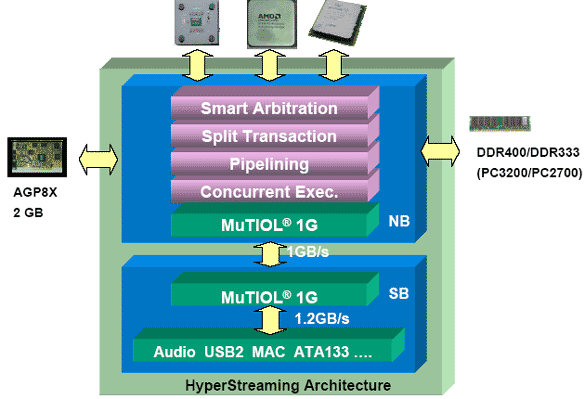The King of the Heap: 4 Chipsets for the Athlon64
SiS 755
Please click for a larger image
SiS, which used to have a penchant for one-chip solutions (in keeping with its name, Silicon Integrated Systems), has this time opted for a two-chip architecture based mainly on an existing Southbridge, the SiS 964, and a HyperStreaming interface of its own making.
The 964 is an ultra-modern Southbridge that has everything except a Gigabit Ethernet controller and the kitchen sink: two ATA/133 ports, two SATA ports, support for AC97 audio, 100 Mbps MAC, floppy controller, 8 USB ports, PCI controller for up to 6 Busmasters, ACPI 2.0 and modem support.
On its website, SiS explains its HyperStreaming technology with reams of text and a nice Flash animation. Basically, HyperStreaming reduces latencies, speeding up access to all kinds of devices and optimizing data transfer processes.
However, it can't work without SiS's MuTIOL interface between the Northbridge and the Southbridge (Multi-Threaded I/O Link) because it only really makes sense to restructure the data traffic if you have the interface's bandwidth of 1 Gbps. Accordingly, SiS views the 755, together with the 964 Southbridge, more as a closed HyperStreaming system than as a chipset (see image below).
SiS sent us a full featured reference board with goodies such as on-board power and reset buttons. As you can tell from the layout, this board is also ideal for the SiS 760 with integrated graphics (note the open slots for SDRAM chips), which has the same pinout as the 755.
The system was unfairly clocked at 2.010 MHz, which should give it a slight edge over the competition. However, not even this extra boost was enough to make the board shine: VIA's K8T800 beat it out in several disciplines nonetheless.
Get Tom's Hardware's best news and in-depth reviews, straight to your inbox.
SiS has decided to appeal to the overclocking community: its PDF product presentations laud the 10% overclocking potential offered by the SiS 755. Another useful feature is the ability to run the PCI and AGP busses independently of the HyperTransport channel - i.e., at 33 MHz and 66 MHz, respectively. That means that you can increase the HyperTransport clock without overclocking the Southbridge dependent components.
MuTIOL runs at 133 MHz quad-pumped (equivalent to 533 MHz) with 16 bits of bandwidth, which allows it to attain 1 Gbps.
HyperStreaming creates the pipelines and forwards the packets created by MuTIOL as efficiently as possible.

Patrick Schmid was the editor-in-chief for Tom's Hardware from 2005 to 2006. He wrote numerous articles on a wide range of hardware topics, including storage, CPUs, and system builds.





